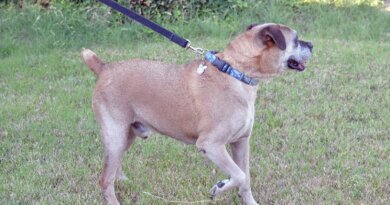Top 6 Common Health Problems for Large Breed Dogs – Top Dog Tips
[ad_1]
Many affectionately call large and giant breed dogs the world’s gentle giants, making loyal and loving companions.
A few large and giant breeds are known for their love of children, acting as nanny dogs in years past.
Taking care of a large breed dog requires education on health conditions they may face, particularly when it comes to preventative care to ensure proper health and well-being.
If your dog presents any of these symptoms, it’s essential to contact your veterinarian.
Although all conditions are manageable or curable, many health problems are time-sensitive—the sooner you seek treatment, the better the prognosis.
If you own a large dog, here are a few health conditions you should know about.
Top 6 Common Health Problems for Large Breed Dogs

Hip Dysplasia
For large breed owners, hip dysplasia is a terrifying thought, but unfortunately, it’s a sad reality for many dogs.
This painful condition will drastically reduce a dog’s quality of life, causing grief for owners having to watch their pup suffer.
Thankfully, educating yourself about health conditions can help keep your dog comfortable.
Hip dysplasia is a common skeletal condition in giant or large breed dogs.
It has a multitude of causes, starting with genetics, which is especially common with Labrador Retrievers, German Shepherds, and Great Danes.
Occasionally, excessive growth rate, improper exercise, and malnutrition can magnify this predisposition.
Nutrition Requirements
Large and giant breed puppies will have unique nutrition requirements significantly different from dogs of other sizes.
Obesity often stresses the dog’s joints, making the issue significantly worse.
The extra strain on your dog’s joints can exacerbate the pre-existing condition, making diet a critical aspect of health.
Glucosamine for Dogs
Glucosamine is an early preventative medication that can help ease the progression of arthritis. Many large breed dog foods often contain glucosamine.
This supplement is part of a comprehensive treatment plan, particularly as a chewable supplement from the veterinarian.
Symptoms of Hip Dysplasia
A few dogs will show symptoms of hip dysplasia as young as four months old. Others will struggle when osteoarthritis appears in later years.
Both situations will develop signs that an owner should be familiar with.
These symptoms may vary depending on the severity of the disease, looseness in the joint, or degree of looseness in the joint.
Signs include:
- Lameness in the hind end
- Decreased activity
- Decreased range of motion,
- Swaying or bunny hopping
- Pain
- Stiffness or limping
- Muscle loss in the thigh
Diagnosing Hip Dysplasia
The veterinarian will perform a physical exam during your dog’s regular assessment.
Occasionally, this evaluation is enough to support a suspicion of hip dysplasia. Other instances may require your dog to undergo definitive tests.
These tests may include an x-ray or radiograph.
Treatment for Hip Dysplasia
There are several different treatment options available for hip dysplasia in dogs—these range from mild lifestyle modifications to surgery.
For less extreme cases, a nonsurgical approach may work better.

Bloat in Dogs
Bloat is considered a medical emergency that will impact dogs in the prime of life.
Knowing the key signs and symptoms can keep your dog safe, as early treatment is imperative.
Gastric dilation-volvulus (GDV) is also called twisted stomach or bloat.
It’s a severe medical condition with the potential to develop into a life-threatening emergency.
No home remedies or options are available, with all treatment options being time sensitive.
Gastric dilation is one part of the condition with a build-up of air in the dog’s stomach. When this condition reaches the volvulus, it becomes exceptionally dangerous.
Volvulus occurs when the gas puts pressure on the dog’s diaphragm, making breathing difficult.
As the air-filled stomach pushes on veins, blood no longer returns to the dog’s heart.
Occasionally, this condition can cause the stomach to rotate, which cuts off the blood supply to the stomach.
Symptoms of Bloat
The classic symptoms of bloat include an enlargement of the dog’s stomach and abdomen, salivation, retching, and restlessness.
Most occurrences start after consuming a large meal or water, particularly if the animal jumps into exercise.
Occasionally, your dog might whine if you press on his stomach. These conditions can impact dogs of all ages without a known cause.
All symptoms of bloat should be treated as a medical emergency. Treatment involves surgical treatment to untwist the stomach.

Aortic Stenosis in Dogs
Aortic stenosis is the narrowing of the aortic valve, controlling the blood flow from the left ventricle to the aorta ventricular outflow tract.
Unfortunately, the obstruction will place undue pressure on the heart, forcing the muscle to increase in size to maintain blood flow.
This condition is congenital (present at birth) and typically associated with large or giant breed dogs.
Currently, it is the second most common congenital heart defect in dogs.
The Symptoms of Aortic Stenosis
Clinically, there are three types of aortic stenosis: supravalvular (present above the valve), subvalvular (present below the valve), and valvular (present at birth).
This heart defect will often appear over the first few weeks to months of their life.
Symptoms may occur at any stage in life, depending on the severity of the obstruction.
Common symptoms of this condition may vary slightly, but most will include the following:
- Abnormal lung sounds
- Ongoing rapid breathing
- Difficulty breathing
- Loss of consciousness
- Congestive heart failure
A dog is medically diagnosed with this condition after presenting with symptoms.
Owners will need to give a comprehensive history of the dog’s health, and the veterinarian will perform a complete physical.
The physical exam will typically reveal an abnormal heart sound, which may suggest an irregular heart valve function.
Your veterinarian may also complete laboratory tests, including bloodwork and urinalysis (although results are typically normal).
Treatment of Aortic Stenosis
Unfortunately, treatments for this condition are controversial and will vary among experts.
Most will agree therapy aims to treat complications of the defect instead of open-heart surgery.
The prognosis of this surgery on dogs isn’t favorable and therefore isn’t recommended.

Hypothyroidism in Dogs
Typically, hypothyroidism is caused by one of two diseases: lymphocytic thyroiditis or idiopathic thyroid gland atrophy.
Lymphocytic thyroiditis is the most common cause of hypothyroidism. Veterinarians strongly believe this variation is immune mediated.
This condition holds the thyroid as an abnormal or foreign boy and attacks it. The reason why this occurs is unclear; however, it is hereditary.
Idiopathic thyroid gland atrophy is a condition that replaces normal thyroid tissue with fat tissue. Unfortunately, this condition is poorly understood.
Symptoms of Hypothyroidism
As the metabolic rate slows, every organ in the body is affected.
Most dogs with this condition will gain weight without increased appetite, face lethargy and lack of desire, increased dark pigmentation, or issues with the animal’s coat.
Diagnosing Hypothyroidism
The most common screening for this condition is the total thyroxin (TT4) level. This blood test measures the main thyroid hormone level.
Low levels of total thyroxin with other clinical symptoms suggest hypothyroidism. When a test comes back as low, the dog has hypothyroidism.
The vet will then make a definitive diagnosis when performing free T4 by equilibrium dialysis or thyroid panels that assess multiple levels of thyroxin.
Treating Hypothyroidism
Hypothyroidism is only treatable but not curable. Veterinarians will prescribe an oral thyroid replacement hormone.
The dog receives the drug daily for the rest of its life. The dog will undergo ongoing bloodwork with treatment, as tolerance levels may change over time.
After a month of treatment, the dog submits blood samples to verify the thyroid hormone levels are normal.
The clinic repeats this bloodwork periodically, most frequently every six months.
Close communication is required to ensure your dog receives the correct dose for this condition.
Assuming the dog regularly takes the proper medication daily for hypothyroidism, most dogs can live long and healthy lives.

Panosteitis
Panosteitis is a painful condition that causes inflammation in the shaft or outer surface of one or more long leg bones.
Occasionally, this condition is referred to as growing pains but may cause lameness from one bone to another.
Lameness in the legs will occur suddenly, without a history of trauma or exercise.
Just as humans experience growing pains, panosteitis affects young, rapidly growing large-breed pups.
Statistically, males are affected more than females, although both can develop the problem.
Dogs are usually between five and fourteen months of age, with the first symptoms occurring as early as two months.
Puppies suffering from the condition often have recurring episodes until they reach two years, at which time it spontaneously resolves.
What Causes Panosteitis?
This condition is likely caused by increased pressure within the bone or through stimulation of pain receptors within the periosteum.
Although the underlying cause is unknown, many medical professionals believe stress, genetics, infection, metabolism, or autoimmune conditions may be factors.
Finally, inappropriate nutrition may predispose certain canines to this condition.
Symptoms of Panosteitis
Generally, unexplained and sudden lameness occurs in one or more legs.
Most commonly, symptoms appear in the humerus (upper arm), but they may also include the ulna, radius, tibia, and femur.
The affected bone will become painful to touch. Other symptoms include lethargy, weight loss, anorexia, and fever.
Diagnosing Panosteitis
The veterinarian will examine the dog; the condition may be suspected if the puppy shows pain when the vet applies pressure to the bone.
Diagnosis is often confirmed through x-ray, highlighting the characteristic increase in the density of the impacted bones.

Cherry Eye in Dogs
Cherry eye is the common name for prolapse of the third eyelid gland.
Dogs have an extra or third eyelid inside the lower eyelid, which adds a protective layer for the eye.
This eyelid contains a special gland that produces most of the eye’s protective tear film. When the gland pops out, it’s known as the cherry eye.
Symptoms of Cherry Eye
The prolapse of the third eyelid shows a swollen, red mass on the lower eyelid. The cherry eye may be large or cover significant portions of the cornea.
Alternatively, it may be small or appear randomly.
Owners should immediately bring all signs or symptoms of a cherry eye to their vet’s attention.
Cause of Cherry Eye
As the third eyelid gland is anchored to the lower inner rim of the eye by a fibrous attachment, certain breeds have a weaker attachment.
Unfortunately, this weak attachment causes a prolapse far easier than other breeds.
Treatment for Cherry Eye
Veterinarians must treat the cherry eye as soon as possible to minimize the permanent damage to the eye.
Treatment for this condition requires surgical replacement of the third eyelid gland.
This gland produces approximately fifty percent of the watery portion of the tear film; treatment is critical.
Failing to treat this condition can result in dry eye, which can seriously impact your dog’s vision.
The surgical replacement of the eyelid gland is always the first treatment choice because of the risk of dry eye.
In most situations, the gland will return to normal within weeks of repair.
Between five and twenty percent of cases could experience a re-prolapse of the eyelid gland, requiring additional surgery.
In chronic or severe situations, removal of the gland may be necessary, mainly if the function is absent.
Common Health Problems for Large Dog Breeds: Conclusion
While large and giant breeds are known for their lovable qualities, a few medical issues can pose serious problems if left untreated.
Early intervention and treatment offer the best outcome for your dog, especially in time-sensitive conditions.
These large breed dogs make steadfast companions, particularly those in homes with children.
It’s critical to contact your veterinarian immediately if your dog presents with any of the above symptoms.
Your veterinarian can help you identify and recognize warning signs you might miss.
A large breed dog is patient and loyal, making most gentle giants.
By monitoring your dogs for the warning signs and symptoms associated with these conditions, you’ll ensure a happy and healthy life for your companion.
READ NEXT: 12 Common Health Problems for Small Breeds
[ad_2]
Source link




